Jan 17, 2019 | Volume 33 - 2018
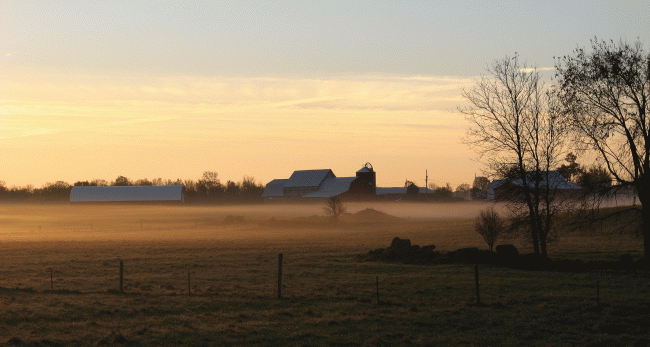
Photo by Karen Davis.
By Linda & Bill McCutcheon
Black Kreek Ranch, near Lansdowne, Ontario, is the home of Brad and Karen Davis and their children. It is also home to a flock of 1,000 ewes, which is surprising in that the Davises always meant to be dairy farmers.
Brad and Karen met at the University of Guelph, where Brad was enrolled in the Agricultural Diploma program and Karen studied for a degree in Animal Science. Brad grew up on a farm near where they live now. It was a cash crop operation, with no livestock. Karen’s family milked cows near Bolton, Ontario. Brad graduated in 2000, and Karen in 2003.
After they were married in 2005, Brad and Karen worked with Karen’s parents on their dairy farm for around five years, then moved to Listowel, Ontario, where Brad helped run a large dairy farm that milked 600 cows. Karen worked for John Deere for three years after graduating from university, and completed her certification in Nutrient Management Strategies and Plans in 2011. She works with Crop Quest Inc., helping farmers who are looking to expand their operations and add either livestock housing or manure storage.
In 2012, Brad and Karen began a search for their own dairy farm. On Brad’s birthday (April 21st), they attended an auction for a farm next to Brad’s family’s place. The farm was sold in about 30 seconds, and Brad and Karen were disappointed not to be the successful buyers. But while at the auction, they met a man who was retiring and had a farm nearby that he was interested in selling to a young couple.
There was one catch: it was a sheep farm with 600 Border Cheviot ewes, including 50 purebreds. Over the next month, Brad and Karen researched sheep and learned everything they could about raising them. A month later, on Mother’s Day, they returned to walk the 300 acres and discuss the future.

Photo by Karen Davis.
Jim and Nancy Kehoe, the sellers, had built a new home close by and said they would help them as long as they were needed. That made all the difference; on September 7, 2012, their journey as sheep farmers began. With the Kehoes’ help they learned how to run the farm, and for the first year they did everything exactly as it had been done before.
By 2013, Brad and Karen were still learning but made some changes based on their own experiences and lifestyle with a young family. They bred the purebred ewes a week later in October, so they would lamb after, instead of during, March break. They started haying in late June instead of July, to improve the quality of their feed. And they started spending more time with the livestock guardian dogs as puppies, so the children would be safer when working around the sheep. They also purchased a John Deere Gator to make it easier to check pastures and move mineral feeders, water bowls, etc., allowing the kids to be more involved in these activities.
The home farm has grown to 400 acres, subdivided into paddocks of 13-15 acres each. The perimeter and interior fences are either pagewire with one hot wire on top, or 7-strand, high-tensile electric. Electric netting is used to further subdivide the paddocks and minimize waste at certain times of year, such as the first grazing of heavy spring pastures at lambing time, or in the fall for market lamb and ewe lamb groups.
For hayland, they rent Brad’s father’s 250 acres, which is close by. This year, they made 1,600 round (4’x4’) bales and 2,100 small, square bales.

Two old dairy barns measure 36’x136’ and 30’x170’. Two Coveralls (not shown) provide hay storage. Photo by Linda McCutcheon.
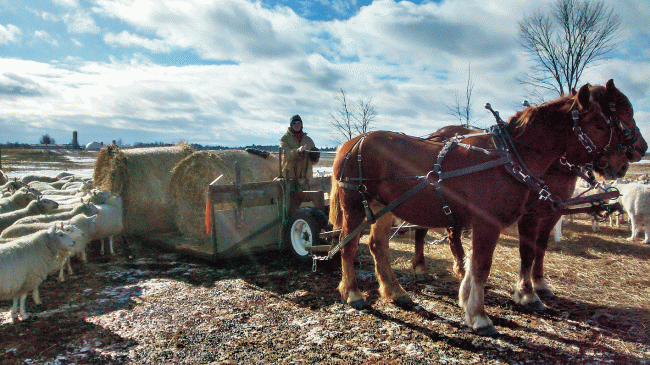
Round bales are delivered to the fields with a team of horses and a homemade wagon that unrolls the bales for the sheep. Photo by Karen Davis.

Border Cheviot ewes following the feed wagon in the fields. Photo by Karen Davis.
Six years on, the flock has grown to 1,000 ewes. There are also 10 guardian dogs, two Border Collies, three horses, six hens and a group of barn cats. The ewes that came with the farm were Border Cheviots. The Border Cheviot is smaller than the better-known North Country Cheviot but, like the North Country, is known for its ability to survive in harsh conditions. Border Cheviot lambs are vigorous and finish at about 65 pounds.
Breeding season begins in October, when 50 purebred ewes are bred for March lambing. The rest of the flock is bred starting on December 17th, with lambing beginning around May 10th.
During the winter, the main flock stays outside, on round bales of hay, in pastures that have a water source for when there is no snow on the ground. If body condition scores indicate, they also get whole corn fed on the ground. The March-lambing ewes winter in the barnyard, and come inside at the beginning of March to get ready for lambing and get started on some whole corn, which they receive right up until they get turned out on grass in April. Ewe lambs are wintered in the barn so they can be fed extra to support their continued growth while pregnant.
Hay is delivered to the field by a homemade, horse-drawn wagon/sleigh pulled by a team of horses. An attachment on the rear allows the bales to be unrolled. Using horses saves starting a tractor in cold weather and the horses don’t leave ruts in the fields. It also makes it easier to avoid running over the ewes as they race in and around the feed wagon. Leaving the ewes out, and feeding the hay on the fields over the winter, also spreads both manure and hayseed.
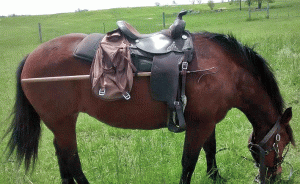
Brad uses a saddle horse to check the lambing ewes. Photo by Karen Davis.
Brad also uses a saddle horse at lambing. The ewes stay calm around the horse, allowing Brad to get closer during checks, and from its back he has a better view of the pastures and the sheep. The horse is also much quieter than any vehicle, allowing Brad to hear if a ewe is having a problem.
Lambs born in May are raised on grass, unless there is an early frost or they run out of grass. When that happens, the lambs are finished in the barn on a complete pellet, which they have had access to each night while being pastured. The ewes that lambed in March, and their lambs, join the main flock when the whole group is turned out onto grass around April 20th. These lambs get to stay on their mothers and are weaned with the rest of the lambs, for ease of management. The target weaning date is August 10th, when the youngest lambs are at least 60 days old. The date varies slightly from year to year, depending on grass volumes.

Shortly after buying the farm, the family suffered a setback when their drive shed burned and they had to build a new one. Photo by Karen Davis.
The goal each year is to market all the lambs before Christmas. The Border Cheviot lambs are finished from October through December, at an average weight of 68 pounds. The Davises have their own trailer, and the round trip to the Ontario Livestock Exchange (OLEX) in Waterloo takes about eight hours.
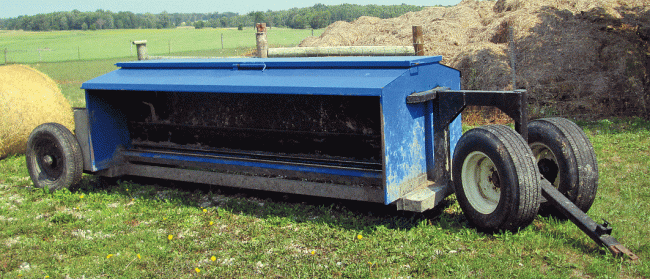
A neighbour welded a set of old axles from the farm onto this double-sided, Marweld feeder, used to supplement ewe lamb replacements after weaning. Photo by Karen Davis.
The flock production is currently about 1.2 lambs marketed per ewe exposed to the ram. In an effort to improve on that, Brad and Karen purchased six Romanov rams in August of 2016 and used them to breed 250 ewes that year.
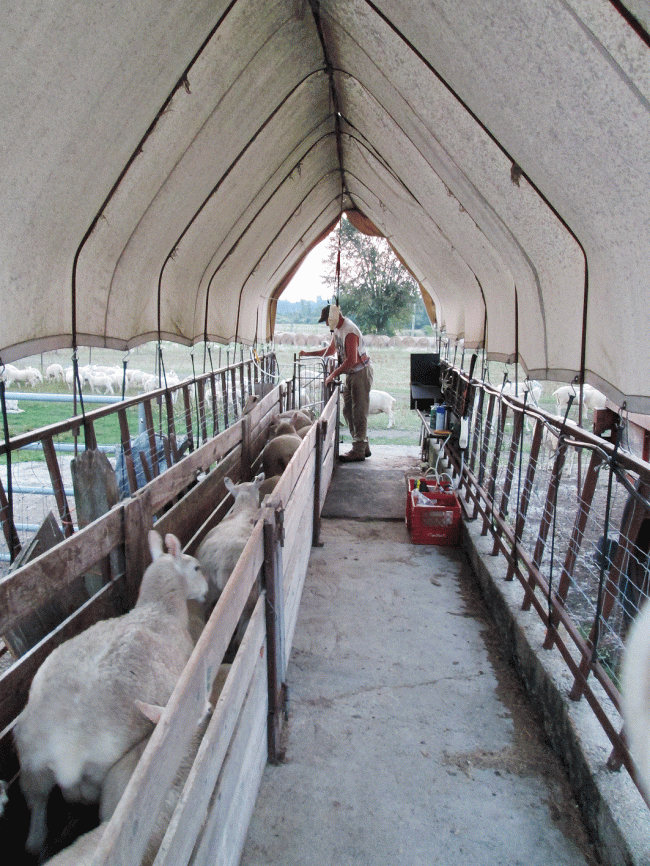
This converted cattle feed bunk works well as a covered, outdoor handling system, where most of the work with the animals is done. A second handling system inside the barn is used to weigh market lambs. Photo by Karen Davis.
The F1 Romanov x Border Cheviot lambs born in 2017 went to market up to 30 lb. heavier than the Border Cheviots, but required significantly more feed to finish. The Davises kept 90 F1 ewe lambs as replacements, and bred them back to Border Cheviot rams in the fall of 2017. They also kept several of the F1 ram lambs, which were bred to a total of 385 Border Cheviot ewes.

The black wool of the Romanovs is recessive, so crosses with it are white: (l to r): Border Cheviot ewe, F1 Romanov x Cheviot ewe born in 2017, Border Cheviot lamb, ¼ Romanov-¾ Border Cheviot lamb. Photo by Karen Davis.
This year the Davises plan to keep approximately 250 replacement females, all from the crossbred groups, plus about 15 crossbred ram lambs. The exact numbers and mating groups are still being sorted out.
The plan is to convert the main commercial flock into ¾ Border Cheviot-¼ Romanov ewes, which will probably take five to seven years. By breeding these ewes back to the Border Cheviot rams again, Brad and Karen hope to end up with more lambs, without substantially changing the finished weight of their lambs. They also hope to sell F1 Romanov x Border Cheviot ewe lambs to other producers in the future.

The Black Kreek Ranch team (l to r): Karen, Della, Erica, Colby and Brad Davis. Photo by Linda McCutcheon.
Black Kreek Ranch is an ‘all hands on deck’ operation. Karen and Brad both drive tractors to harvest the hay and work the farm. Colby (12) also drives a tractor and collects round bales from the fields. Erica (10) helps saddle the horses and drives the Gator. Della (8) collects eggs, feeds the cats, and also drives the Gator. All of the children help with moving and sorting the sheep. They work hard and play hard, at soccer, hockey, football, swimming, piano, dance and 4H.
Ewe lambs, and the March-lambing ewes, are sheared around March 10th. They remain in the barn until around April 20th, when they go outside to make room for the main flock to come in for shearing. These animals will have access to the barn for 10-14 days before being put out on pasture for lambing. The wool is sold to the Canadian Co-operative Wool Growers in Carleton Place. In 2014, the Davises received a Certificate of Merit from the CCWG for the quality of their wool clip.
Brad and Karen work hard to be on top of diseases that could enter their property and flock. Parasites are monitored closely through fecal egg counts completed by Karen. The ewes are normally treated only a couple of times each year, as needed. They don’t currently have a resistance issue, but they are concerned about the limited assortment of medications available in Canada and are watching for it. They move the sheep often to keep the worm population down.
When the Davises purchased the farm, the flock had a serious problem with coccidiosis. In recent years, they have been successful in dealing with this issue by treating lambs with Baycox at 3–4 weeks of age, when they are docked. They have a good relationship with an excellent sheep vet who provides good advice, does yearly flock visits, and is in contact with them to see how things are going.
Brad and Karen say their biggest challenge so far has been accepting that death loss is higher in sheep than in other livestock they have dealt with. Their advice to new producers is to find a mentor to help them learn the ropes, find a good vet and nutritionist, and become part of a support group. There is also a Facebook page (Ontario Lamb Producers / WOLPA) that they have found helpful.
As we walked the farm with Brad and Karen, and chatted about their experiences over the last six years, we were impressed with their desire and passion. They were willing to learn from others, but also to do their own research and try new things, to continue to improve and keep their flock as healthy and profitable as they can.
Statistics Canada reported last year that the average Canadian farmer is 55 years old and that 92% of farmers do not have a succession plan. The Davis family and their story offers hope for aging farmers who do not have family members wanting to succeed them. Perhaps this story will inspire other sheep farmers approaching retirement to consider selling their farm as an ongoing operation to a young couple, and to help with the transition.

Bill and Linda McCutcheon raise sheep at Riverside Heritage Farm outside of Napanee, Ontario.

Source: www.ontariosheep.org

Source: www.ontariosheep.org



















